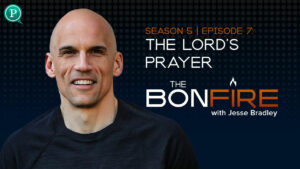Stepping away from screens can be tough, and awkward. We don’t always know what to do with our time, and sometimes it just feels like punishment — for everyone. So how do we do this well? How do we take time back from tech?
In today’s conversation we’ll cover four steps in this journey we can begin today. We’ll discuss how to plan your:
- Tech (what and where)
- Day (4 chunks that work for nearly all ages)
- Play (simple, analog, present)
- Rest (in both our work and our play)
Transcription:
Nathan [00:00:08] Heavenly Father, thank you for this chance to talk about technology and rest and taking our time back from summer. I ask God for wisdom to speak clearly and that I speak in a way that encourages families today. Would You guide our steps this summer so that these days in this time would be used to glorify You and to grow us to look more like Jesus. In Your name, amen.
Nathan [00:00:28] Hello, everyone, and welcome to the Gospel Tech podcast. My name is Nathan Sutherland, and this podcast is dedicated to helping families love God and use tech. Today we are talking about how do we take our time back from tech this summer? This idea that summer is a change of schedule. It’s a change of rhythm. So how do we intentionally recalibrate where we’re headed? If we already like it, then how do we make sure that we continue this rhythm from what we had with school where there’s a lot of structure. We’re waking up at a certain time to get to school by a certain time to come home by a certain time. And there’s only so many discretionary hours in a day. And a lot of the things we don’t get done during a normal day over the weekend. But that all blows up in summer for most of us.
Nathan [00:01:07] For most of us, summer is rhythms kind of go kaput, either because we have a trip or there’s that unique time extension is now the right word? We’ll call it an extension. Where it doesn’t have a regular rhythm, it doesn’t have a regular flow, and boredom either sets in or we kind of get loose with some of our expectations. But for us, in summer, if we’re intentional, summer can be an amazing time to take our time back and to set on tech the boundaries we want. Not because we’re mad at it, not because we’re scared of it, but because we have things we want to do and people we want to become and a God we want to glorify. And sometimes tech helps us with that, but sometimes tech creeps. So today our conversation is how do we take that back? There’s four steps to it. And as we have this conversation, I want it to be practical and encouraging. This isn’t a Nathan does it right all the time. And so just be more like me conversation. But there will be examples from my life that that we’ve seen work and some spots where it doesn’t. And so we’ll talk about that. And my hope is throughout it all that it’ll be encouraging for you that we can talk big picture about how do we take our tech back or our time back from tech this summer and make this an intentional season of growing independent of technology. So when we go back to school, where do you have good rhythms? And then it’s just adapting to that new structure. So that’s our goal for today. And with no further ado, let’s get this conversation started.
Nathan [00:02:31] Welcome to the Gospel Tech podcast, a resource for parents who feel overwhelmed and outpaced as they raise healthy youth in a tech world. As an educator, parent and tech user, I want to equip parents with the tools, resources, and confidence they need to raise kids who love God and use tech. Thank you to everyone who has helped make this podcast possible. Thank you for listening and for liking, for sharing. Thank you for going to Gospeltech.net and clicking the donate button and being a financial supporter of this ministry. Because this ministry would not work without supporters like you. So thank you for helping us do this.
Nathan [00:03:11] Today, our conversation is about taking our time back from tech this summer. Using that rhythm like I talked about in the introduction, using that new rhythm of time, intentional. And really that’s where we start. We’re going to talk about first, how do we plan where our tech is? Second is how do we plan our day, plan our play, and then plan our rest. So it’s plan where tech is plan our day, plan our play, and plan our rest. And with that, let’s just jump straight in. Let’s talk first and foremost about where is our tech? Summer is a great chance to look around. We’ve been in the valley oftentimes of school. You get in rhythms, you get in seasons, you get in the spots where it’s not good if it was every single day, but you can get through it for a week, two weeks, maybe a month and a half, like we did back in November when we just got sick for 6 to 8 straight weeks with like five colds at one point went to the doctor. The doctor was like, “Yeah, we’re not going to do anything. Like this is just what’s happening right now.” So that there seasons, no one would pick that, but it happens. But now we’re in summer and it’s a different season, a different rhythm. We got to make sure we are intentional with what tech we’re using and where it is. So that’s really the first two is first, make a list, write down on a sticky note, sit your family down. If they’re over the age of six, they can help with this. Write down, what tech to even have? Start with the the smart TV on the on the wall. If you’ve got one of those if it has a smart DVD player, that means the DVD player has the ability to access the Internet. That is a thing, especially those wireless DVD players. If there are streaming devices like a Roku or anything like that, it can be something that’s nailed into the wall. It could be something that’s attached to another device, could be something be unplugged and taken to another screen and used there. You just want to know what it is. All dead cell phones, current working smartphones, tablets, e-readers, gaming devices, laptops, personal computers. If it is a digital device, write it down. Now, you know what it is. Where is it, though? Is it in people’s bedrooms? Is it in public living places? Is it just in a box out in the garage? And no one really knows why we still have this thing. Let’s assess that. Some of that needs to get recycled. Some of it might just need to get destroyed. If you don’t feel comfortable recycling it, some of it could be sold. Some of it needs to be brought out of mothballs and put to good use or given to a friend who can make better use of it. That’s awesome. But just assess it. Where is your tech and what tech do you even have? Is it tool or drool tech? Is it fitting your rhythm and your focus for this season of life with your family?
Nathan [00:05:37] And then we moved to that second piece, which is, All right, let’s plan our day, Let’s make our tech wait for us. As Andy Crouch says in the Tech Wise Family. Just an idea that’s absolutely been pivotal in the way I’ve gone about thinking about technology because we’re not scared of it. We will use it, but we’re not just going to use it any time we think of it. We’re not just going to use it because we can. In fact, we’re going have a plan and use it when it fits in my life. Yes, I loved video games and I had to go through a season. I was like, no video games. I’m not going to be doing this. And it took intentional daily fortitude and prayer to make that happen. And at this point, I can write down my day and be like, I don’t actually know when it would fit. Like if I’m not giving up sleep and I’m only getting 7 hours on a good night, where would my video games happen? Like it just won’t work. That’s what we’re going to do, right? Just plan out your priorities and there’s a really good chance tech is going to fit in its own little spot. By that I mean plan your day. It doesn’t. You don’t have to be a super Type A to do this. I’m not super type-A. I’m married to a delightfully type-A person, but I am not. And yet this really helps me. I actually need more structure than maybe your average type-A person, because I’m not type-A, because it’s not natural. I have to have some kind of a a rhythm to go through. So when you plan your day, let me use a hypothetical or not a hypothetical, an exact example from my family, the opposite of a hypothetical. This is what we do, and I share that. I almost didn’t share this because people get really comparison driven or you’re going to be like super judgy on how we do it. This is just an example. Use as much or as little as you’d like. It’s working for us and we’ll change it when it doesn’t. So we are not at all married to this. This isn’t biblically based beyond the idea that we want to use our time well.
Nathan [00:07:20] So with our kiddos, if you wake up early, we tell them to play quietly. We give them a number of options that fit within that. For them that’s Legos. We have a a part of the house where our Legos are stored. You can go build Legos if you want. You can read on your own, you can play independently. The reason we can’t let them play together is inevitably wrestling matches break out and it ends very poorly. So feel free to get out the drawing paper from the art section and you can, you know, and by the art section it sounded much fancier. It’s literally an IKEA three tiered like rolling bin that’s in a corner. He’s got paper on one level and crayons and pencils on another and little vertical storage racks where the kids drop all their like a workbook things. It’s a holdover from when we homeschool during COVID and the kids just like having those like there’s a math one and a reading one and one that’s just mazes and puzzles, like cool and they’re Highlights Magazines. Okay, you can go do the the little art corner stuff. So there’s no that don’t picture like a full dedicated portion of our house if you have that that’s awesome. We don’t.
Nathan [00:08:21] But you can do that so that’s before breakfast is going to be at 7:30am. That’s not military time. That just happens to be like with my wake up rhythms. And when I finish my I generally do my quiet time before breakfast because then life happens. So by 7:30am I’ve got breakfast ready. Cool. So 7:30 to 8am and by eight we have stuff you must do, stuff you can do. And then like whatever the family plan is for the day. So by 8:30, you should have probably finished your must do’s. And this is like you got to pick two family chores, clean the table, clear the dishes, clear the dishwasher like you got to do something that shows you’re a part of this family and that we’re not just like you’re short order chefs and doing stuff for you. Then there’s things you can do. You can practice piano right now, read your Bible, read a book, you can go play outside. Those are your options right now. And then by about 9:30 is when the like, first thing of our day would start. This can be your errands. This could be just like whatever your rhythm is going to be for your family. It could be when you see a friend group. We generally do that in the afternoon, but this morning time is like, Great, You guys have a list of to-do’s. If you have a firstborn child, you probably have someone with some to-do’s in your life, but maybe it’s not your first born. I know not everyone’s like that. Our firstborn has a list. And so this is we’re like, “Owen, you’ve got an hour and a half to, like, do your list.”.
Nathan [00:09:37] The idea behind this concept, the reason I’m walking you through this, is you can very quickly structure your day. You may have a job that you’re going to be working during this. This gives your kids some structure. The structure is good. It’s loving, it’s intentional, it’s not bossy, it’s not crushing the fun out. Instead, it’s giving them a framework with which to have fun. So it’s not just, oh, man, it’s 8:30 in the morning. I got to make till 8:30 tonight before these kids go to bed. It’s a little bite sized chunks so that when noon rolls around, we started 9:30. You got two and a half hours to do something. By noon, we have lunch until one, and then some I’ll come back to later. But we have practiced quiet time. You can do it for 15 minutes. You can do it for 30. Our kids know that it’s going to be 2 hours. You’re going to go from 1 to 3. That is not to say that that’s preferable. That’s just we found that when that gets cut down, they lose their minds. They don’t make it till 8 p.m. and 8pm’s a pretty early bedtime for kids that are nine, seven and four. They don’t make it. They get grouchy, they get crabby, they get stressed out, they start breaking down to start complaining about stuff. They get this little quiet span in the middle. We didn’t start with 2 hours. We started with 15 minutes. After a few days, we made it 20. And it’s just get used to being in your thoughts. 15 minutes is an interminable amount of time. Interminable amount of time. That they say the word. If you’re not used to it, if you’re used to constantly being fed that next exciting adventure, it’s going to be hard. Practice it. This is where they do their independent time. We can we’ll talk about this later. I’ve got a whole list of some little analog adventure ideas, but just know that by this point it’s 2:30 or three in the afternoon and this is where generally we invite people over or we go to people we generally keep our mornings clear because again, we found our kids fizzle out too many days in a row of packing those mornings full, they explode. Nothing happens at the house. There’s a ton of chores to do and the family kind of melts. So we reserve morning for family time, morning for our personal activities, morning for getting stuff done, afternoons for seeing people also comes with the favor of like at some point the day ends and like our kids will have to go to bed and so we know that like we’re going to save that last little batch of energy all at once.
Nathan [00:11:48] What we’ve just done then, excuse me, as we have planned our time, we’ve made sure we know what tech we have and where it is. We’ve planned our day, not to the nth degree, not 15 minute segments where we know everything but kind of blocks. We know roughly what we’re going to be doing when and our kids will know, and especially with our kids, two of the three really like having a plan. I get asked every night before how they go to bed, who are we seeing tomorrow? And she doesn’t want to say don’t one here. “Like, well, in three weeks we’re going to…” No, it’s, “Tomorrow morning before quiet time like who am I going to see?” And like that in her brain is an important thing she wants to know before she goes to bed. If we’re not seeing anyone, I can tell her that. But she will be asking and a certain eldest of mine also likes to know there’s a plan. So we planned our day. We’ve got that idea.
Nathan [00:12:34] The third thing we’re going to do then is plan our play, and that’s in that same schedule. What do we do for play? And I’m going to break this down to three things. It’s going to be simple. It’s going to be analog and it’s going to be present. Anytime you had this kind of conversation, some of you are already like, You’re driving in your car or you listen to me on AirPods while you’re doing the dishes or whatever. And you’re just going about normal life. And I’m stressing you out by talking about this plan you have to make and it has to have all these. Please don’t hear me. All I talked about was basically four chunks of the day, starting with breakfast. There’s a chunk on a quiet time and a chunk, too. That’s it. That’s enough of a plan, because now we can start to plug and play what goes in there. Maybe tech time for you is that? Our kids love watching shows. So we’re going to say, “Hey, in the afternoon chunk, you can watch 30 minutes.” You’re going to have a wild crats you’re going to watch. Or maybe it’s a whatever. I think it’s Tuesday evenings now when the Dude Perfect videos drop. So we’re going to watch to Dude Perfect video together because we’re not sending our kids online to YouTube on their own. You might do that. I would strongly encourage you to co-watch. At least make sure the volume is up in there in the same room as you. YouTube can go sideways, especially with the introduction of reels and promoted material. You can get all sorts of stuff that shows up on there that you don’t want.
Nathan [00:13:45] So with that in mind, that might be our show time. That’s great. But the three that I’m going to be talking about that aren’t co watching shows or movies or movie night or any of that is simple analog and present. The first is anything can be a game. It has to be simple. This can be, like I mentioned the other day, going on a walk and throwing a ball to each other. It can be floating a leaf in a lake and trying to sink it with a rock. All you need to have a simple game is you need a challenge they’re going to try to do some rules in a way to know if you did it, that’s it. You can stand on one foot cover and I do whatever you want. There’s any number of silly games you can make up, but do them together. Have simple fun. It doesn’t have to be expensive. You don’t have to go anywhere and it doesn’t have to be a game you ever play again. You can just make it up while you’re doing something else together. It can actually be a simple for some of our family who’s competitive as who can pick a bucket of weeds first. It works. They actually like it. It is fun and you’re welcome to throw in a fun candy prize or something if they do it.
Nathan [00:14:44] The second is analog and this is where we’re talking about the non screen activities. Certainly have your screen time. I would encourage you strongly to make a time of day when that’s going to happen and leave it there. It’s great. This is when we check our social media. This is when we play that game. This is when we watch that show. But we’re not just doing it all the time. We’re not doing it whatever we think about it, we’re not running to our room and doing this on a screen in our room because we know where our tech is and we know what tech we’re using. We have a family framework that helps us decide that. So, some non screen activities. So I went through and just like in the last seven days, I don’t want to go like, well, my kids used to last seven days. Here’s some examples for what they do. They might do this for 5 minutes, 15 minutes, or sometimes they get sucked into that beautiful flow where you like don’t want to talk to them because they’re just so into it and they will play it for 30, 45 minutes and it’s good play and it’s creative play. So just think about this. Which one or three of these might work with your kids? Legos are a thing for our kids. That’s Owen, Henry, and Hadley they all love it. Reading only Owen and Henry. Hadley loves being read to so sometimes will assign a boy to read to Hadley Hey, go read this book. It’s a Berenstain bears or whatever. It’s 5 minutes, but it’s cooperative and it’s something that she enjoys and models it.
Nathan [00:15:55] Drawing, we’ll use Kid’s art hub. It’s on YouTube. Again, we’ll do it together and we’ll do little projects and drawings that are seasonal or thematic, and Hadley loves jumping in on those. So all five of us can do that.
Nathan [00:16:09] Dancing. This is only Hadley, but she’ll suck her brother’s into it and it’s awesome. We just use the record player out front and put on some old record. And Hadley will dance to no music if she has to.
Nathan [00:16:21] Trampoline time. There’s one at Walmart that’s like 300 bucks. It’s the one that we have. It’s like a 16 footer. It’s huge, but you can find trampolines and they are just a beautiful outdoor playroom if you haven’t had one. And by little $2 balls from like Walmart or something and throw them on their kids will have a great time. Bikes in the front yard we have we live in a cul de sac, so it works.
Nathan [00:16:46] Calvin Ball. I didn’t teach this to them, but I kind of wish I had. They read Calvin and Hobbes and they basically play baseball. That includes wrestling and has, I think 15 bases is what they’re currently playing. It’s on both sides of home plate. So one side of the cul de sac and then the other side behind you also has bases. They use ghost runners. It’s very complicated. There’s a number of other implements in baseball involved, but that’s beautiful. Whatever your kids play, maybe they played treehouse or family or whatever, like they’re going to make up a game. Sure, that’s something they can do.
Nathan [00:17:18] Storytime as a family, it’s usually at night. We’re currently reading Treasure Island, which is fairly violent and gruesome. Maybe it’s not your cup of tea, but the Narwhal books or Narnia or whatever silly book story you’ve got.
Nathan [00:17:30] Baking. This is Henry and Hadley specifically. They love baking.
Nathan [00:17:34] Building. This is with Owen. I actually just showed him how to use a chop saw this week. I used it with him, Don’t worry. But we made him a little frame. He’s getting ready for the 4th of July kid with the plan. And he is he framed in from some scrap wood. This, like three foot by one and a half foot battlefield, basically where he’s going to buy little tanks and smoke bombs and like put this thing together and he doesn’t want them to run away. So we made this.
Nathan [00:18:01] Board games. If you got young kids something like Animal Upon Animal, you can Amazon that or go to your local board game shop Carcassonne for your middle kind of group of kids like seven and older and then something like a marvel dice thrown. It’s combat Yahtzee with Marvel characters, something like that. There’s lots of great games. Email me if you want suggestions. I’ve got lists.
Nathan [00:18:24] Any kind of sport or practice in an instrument like these are what we’ve done in the last seven days. So when we say play and it needs to be analog, there’s lots of awesome things you can play that don’t have to be punishment or don’t have to be done to teach you character. All right? Like they don’t have to be like, mean or vindictive. Like they can actually be fun and your child can get into it, but it does take practice and they won’t take to it like a fish to water the first time. Some of it takes work and takes some rhythm and takes getting into this summer piece, which is why we’re taking back time from tech. Because the one thing that will fight you the most on analog tech is digital tech. Tech that gives you fun at the touch of a finger, at the press of a button. And it keeps the fun coming because it’s designed for engagement. It wants your time, your focus, your money. And my goodness, it’s hard to have real life fun when fun is so just pushed on you. All you have to do is show up on a website and now fun just comes at you and you never had to think about it because there were teams of people making fun for you. And while that can be enjoyable, it’s not always the best. It can train our brains out of this amazing ability God gave us to actually have fun and co play and all that is an important part of growing for young people. So we now have our simple fun. We can do anything for fun, including going on a walk can be fun, you can bring a game into it, we can have analog fun. That was just what we did in the last week. And that’s not because we’re impressive. It’s because Anna wanted to bake cookies and invited a couple of the kids. And Hadley knows how to put on a record herself, and the boys were reading anyway, so we told them to read out loud. Like just making those things happen is a way to involve some analog play. And then finally it’s being present. And by this I mean when you look at what your child is doing for fun, simply ask is it helping them be more present? It’s a reset. But we’re instead of looking at the reset of, well, is this tech good or bad, we’re looking at our child and saying, is this activity promoting who God’s made them to be? So when they’re more present, they’re just more of who God made them to be. They’re blooming right? They’re producing good fruit. They got more love, joy, peace, patience, kindness, goodness, faithfulness, gentleness and self-control when they do this activity. Awesome, right? That’s what I want to see for my kids. But if it’s not the case, I’m all right. Maybe this isn’t the right activities at the right time. We’re not introducing it right. We want to bring this out. So when we talk about being present, we’re talking about that reset. Does it improve your relationships and responsibilities, your emotions, sleep, enjoyment and time? We’ve done that a lot. I’ve got whole episodes on resets. I won’t dive any further there. But that idea of use the reset in the session in this situation and say, “Does this help my child grow and learn and be awesome?” Cool.
Nathan [00:21:07] One of the great ways, if you want to, a great way to be present is get out in nature. And this can be intimidating, especially if you’re not used to it. I know I have been intimidated and still get regularly intimidated. I have friends who just for fun, will take their two small children and go into the woods for days like that’s normal for them. And if that’s you, that’s awesome. Good for you. That’s not me. That’s not natural for me. I didn’t grow up doing that and it’s very intimidating. So for me, we have local woods, we have family with land that’s super cool. So we’ll go down to that family. My parents, my kids grandparents have land a few acres and it’s got beautiful northwest trees on it. We can go down there and the kids will just run willy nilly through it and come out occasionally because they ran straight through a batch of nettles, which if you don’t know nettles, they’re not like poison oak or anything. They’re just this thing and burn. And it’s unfortunate, but nothing crazy. You just run burns on it or a banana slug if you can find one, and they’ll be fine. But that’s great. But what about if we don’t have family with woods on their property? Like, All right, local parks, like, find a community park, throw a Frisbee, throw a ball to it for an hour, max hour. If it’s your first time, 30 minutes, and plant a treat into it like, great, we’re going to get coffee on our way there on our way back. Cool. Then go State park. You probably have some beautiful state parks wherever you live. And here in the northwest, we have beaches. And so in the summer, if you can get down to a beach and you can skip some rocks and spot some seals and like go hit stuff with driftwood, like, that’s amazing. Do it. State parks are incredible. They’re not expensive. They’re not typically super far away. And you can make an absolute awesome opportunity to go see some wildflowers and see nature and process with the state parks that are already marked for you. You can get into some of the natural play. How do you be present? Well, nature’s awesome for that because nature’s really slow. Nature’s really old, Nature’s really big and nature is really good at drying out, wandering off from us. And it do know that your kid might be underwhelmed. Like, just think about it. Trees don’t give you level ups. Ponds don’t generally have Kraken swarming out of them. It’s very uncommon to find any legendary loot along the path when you’re walking to or from this destination. So just keep that in mind when you go that your child isn’t being a brat. Your child isn’t trying to be difficult if they’re not super enthralled by their first experience with nature. Yes, we’re wired for it. But digital technology, specifically drool tech, is so good at getting us to feel the excitement of the moment that sometimes the presence of real nature can be a little overwhelming while also being underwhelming. Overwhelming in that it’s so quiet, it’s so immense, it’s so old. We don’t know what to do with it and underwhelming that it’s not making the fun for us. We have to make fun and our brain has to learn how to do that.
Nathan [00:23:54] So local parks, state parks, and then finally would be national parks. And this is where people get intimidated because like now I just picture backpacking and having an RV or going out in a camper, which is great. Again, I have friends who do these things and it’s awesome and I’m so proud of them and inspired and one day I hope to do it, but that’s just not where I’m at. I’m not there energy wise, planning wise, comfort wise. So I do two things. One, we already have it on the calendar. We’re literally going to leave our house and drive 2 hours to a national park. Again northwest, so I can get to Rainier in 2 hours. So if I leave at 8 a.m. and get there by ten, we’ll probably go 7 a.m., leave, get there by nine because Rainier gets packed in the summer. I can go from nine and hike until my children collapse, which will be at 4 hours max. Like they’re not going to hike more than 4 hours, 5 hours up there. So I went, what, 9 to 3 lunch break, 9 to 4. I’m back by 6 p.m.. Like I could eat dinner at my house, pack a lunch and that’s it. Like bring some snacks. And I went to a national park and we saw some of the most beautiful examples of all of God’s creation. If you’ve not been to Paradise in Mount Rainier or even a sunrise on the other side, please go. Please visit the state of Washington and go. It will blow your mind. I live here and I still have my mind blown when I go. Just the amount of biodiversity and the incredible scale of the mountains and the foothills and the sheer volume of the people that visit. And yet it’s still there and no one had to plant it. It’s like Disneyland for plants, but no one had to, like, make it happen. I guess people had to protect it. But there’s that. That idea, though, national parks are incredible. They are an absolute resource for our children, for understanding things bigger than themselves. So please get out in it. All right. I’ve spent a lot of time on nature. I’ll move along.
Nathan [00:25:38] The last piece I wanted to talk about was planning our rest. We’re planning our play and we’re planning our Oh, my goodness. I play is going to be simple analog and present using a reset. And the nature was my good long side tangent. Then planning our rest would be the last piece. And this is I guess a subnet setting under being present. But just with rest. I talked about this a little bit ago, but it came up again because with me I’m bad at resting while I’m anyway, I want to make any excuses. I am bad at resting. I like to be busy, I like to be around, people like to be going and that’s great. Certainly that time in the middle of the day is a wonderful way to practice rest. We’re going to take 15 minutes kids we’re going to plan around, practice rest. We’re going to practice rest by breaking up the work we do into chunks. I was in the middle of a writing project. I’m at the tail end of it now, but I was absolutely swamped and it was crushing my attitude and my ability to focus and I was feeling super overwhelmed and my good friend and brother in law, Justin, You guys have met from a podcast fame also happens to be an Agile coach and a Scrum master. Basically, he helps people do their work efficiently and he sat down. He goes, Two things, Nathan. First, to plan your rest, you need to swallow the frog. First thing in your plan for your day needs to be the thing that most intimidates you that you just don’t want to do, and you’re going to keep punting down the road and making up stupid side projects to not address. I had those. There were like five of them. I needed to do them and just plan one a day for a week. By the end of week they were all done. Awesome. So that’s the first. And the second is 25 five. Take your work break in at a 25 minutes and then take five minute breaks, not five minute breaks of playing a game, not five minute breaks of watching YouTube. He had to tell me both of this means that five minute breaks, you can walk, you can stretch, you could read. Those are the three things you can do on your five minute break. Then you come back and you put in another 25 five and wouldn’t you know it, I got some work done, I got some good thoughts and that I look at. I’m like, Wow, that doesn’t even sound like me like that. That’s solid. And it’s worked for the last month, so I wanted to share that with you. When we talk about planning rest that resting amidst our work, it’s working intentionally. It’s not working and grinding ourselves into dust. It’s not working to try to attain our purpose. It’s working on purpose. There’s work to be done. Great. There was work in the garden. In a perfect world, there was still work. You’re going to have work. You’re going to go to heaven, worship God and work. It’s going to be in every part of it. Even with your beautiful new renewed body. It’s going to happen. So let’s do it here and make rest part of that. So we swallow the frog. We do our 25 five, we plan our time of day for rest, and we be basically intentionally making our tech wait for us.
Nathan [00:28:18] And that’s the last piece of planning. Our rest is make sure you keep tech in its proper place. Make sure you make tech, wait for you that, yeah, you’re going to use tech. You’re going to use it on purpose, not for purpose. So you’ll check social media, you’ll play your games, you’ll watch your shows, you’ll watch movies, but it’s going to be intentional where you go to use it and walk away.
Nathan [00:28:40] So that’s my hope for you for this summer. This is a beautiful time to take some time back to plan that time out, intentionally look forward and say, hey, let’s schedule in some space, maybe a day without tech or a few days without tech? That’s cool. Maybe it’s just an hour. But whatever it is for you, pick one right now that pushes those boundaries on what you’re comfortable with that gets you out. And really, at the end of the day, that you are being intentional about where your tech is and what tech you’re using, that you’ve got a plan for your day, that you’re back in those four chunks that we talked about, that you’re planning your play and that you’re planning your rest. That your rest is extending from your ability to be present. And in all of this, what are we doing? Well, we’re giving ourselves space to abide. We’re setting our priorities down so we make sure we’re using tech on purpose, not for purpose. We’re modeling for our kids, how tech works in our lives. And we’re getting out in nature and in play to things that God designed for us and in us that show His character and His goodness, right? The mountains declares glory, the sunsets, the rain and the sun equally show God’s goodness. It’s part of a of His common grace on all people. And that is something we want our children to see and experience for ourselves and have conversations, not because nature is magical or it’s going to save our kids, but because nature is designed by God to tell us something about Himself. So let’s get out in it.
Nathan [00:30:01] All right, That’s it. I’m off my soapbox. Thank you all for listening to this. I hope it was encouraging and maybe a little challenging, and I hope this summer that you’re going to find the time to take some time back from tech and use it intentionally to build relationships and to be more of who God has called you to be. If this was encouraging, would you consider sharing it with others who might be able to be encouraged by it and grow from it? Would you join us next week as well as we continue this conversation about how we can love God and use tech.







